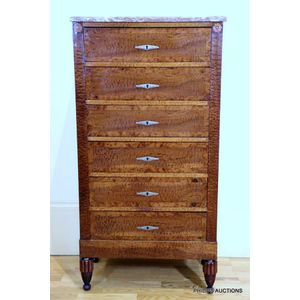Art Deco Marble Top Chest of Drawers
An Art Deco six drawer chest in fiddle back and burr timbers, circa 1930, a rouge and grey marble top, small inlaid rosettes with Mother-of-pearl decorations to the upper edges, the equal drawers with decorative lozenge escutcheons and raised on short legs of ribbed and conical profile, height 126 cm, width 65 cm, depth 37 cm
You must be a subscriber, and be logged in to view price and dealer details.
Subscribe Now to view actual auction price for this item
When you subscribe, you have the option of setting the currency in which to display prices to $Au, $US, $NZ or Stg.
This item has been sold, and the description, image and price are for reference purposes only.
- Art Deco Period - The Art Deco period was a cultural movement that emerged in the 1920s and 1930s, and was characterized by its emphasis on modernism, luxury, and elegance. The name "Art Deco" comes from the Exposition Internationale des Arts Décoratifs et Industriels Modernes, a large exhibition held in Paris in 1925 that showcased the latest trends in decorative arts.
Art Deco was a reaction against the ornate and elaborate styles of the previous era, and reflected a new modern sensibility. It was characterized by streamlined, geometric shapes, bright colours, and the use of new materials such as chrome, glass, and Bakelite. Art Deco designers sought to create a sense of luxury and sophistication, often incorporating expensive materials such as ivory, marble, and rare woods.
Art Deco had a significant impact on a wide range of artistic fields, including architecture, fashion, graphic design, and interior design. Some of the most iconic examples of Art Deco architecture include the Empire State Building in New York City, the Hoover Building in London, and the Palais de Chaillot in Paris.
The Art Deco period came to an end in the 1940s, as World War II and changing cultural trends led to a shift in artistic styles. However, Art Deco remains an important influence on design and art, and continues to be celebrated for its modernist sensibility and glamorous aesthetic. - Escutcheons - An escutcheon is a plate, made of brass, wood, ivory or ebony, which fits into or over the h keyhole, to protect the edge of the timber keyhole from damage by continual insertions of the key. As a general rule you would expect these escutcheons to be sympathetic in design to the handles of the piece. From the early 19th century escutcheons were sometimes made from ivory, ebony, bone or contrasting wood, often cut in a diamond or shield shape and inlaid into the front. Ivory, in particular, will tend to discolour with age, and certainly should not show up as brilliantly white.
- Mother-Of-Pearl - Mother-of-pearl, technical name "nacre", is the inner layer of a sea shell. The iridescent colours and strength of this material were widely used in the nineteenth century as an inlay in jewellery, furniture, (especially papier mache furniture) and musical instruments.
In the early 1900s it was used to make pearl buttons. Mother-of-pearl is a soft material that is easily cut or engraved.
Nowadays it is a by-product of the oyster, freshwater pearl mussel and abalone industries. - Inlay - Decorative patterns inserted into the main body of a piece of furniture, generally in wood of contrasting colour and grain, though brass, ivory, ebony, shell and sometimes horn have been used. Inlay may consist of a panel of well figured timber inset into a cabinet door front, geometric patterns, or complex and stylized designs of flowers, swags of foliage, fruits and other motifs. As a general rule, in pieces where the carcase is constructed in the solid, the inlay is relatively simple such as stringing, cross banding and herringbone banding. Where more elaborate and decorative work was required veneer was used. Inlay has been fashionable from at least the latter half of the 17th century, when a variety of elaborate forms were developed
- Burr - Burr (or in the USA, burl) is the timber from the knotted roots or deformed branch of the tree, which when cut, displays the small circular knots in various gradations of colour. It is always cut into a decorative veneer, most commonly seen as burr walnut on 19th century furniture.
- Circa - A Latin term meaning 'about', often used in the antique trade to give an approximate date for the piece, usually considered to be five years on either side of the circa year. Thus, circa 1900 means the piece was made about 1900, probably between 1895 and 1905. The expression is sometimes abbreviated to c.1900.
- Fiddleback - A name given to the pattern of the grain in some timbers, where the lines of the grain are compressed and at the same time wavy. Fiddleback grain is prized as a timber for furniture and musical instruments, and is expensive becasue of its scarcity.
In Australia fiddleback graining is found in blackwood. Other non-native timbers that are sometimes found with a fiddleback grain are mahogany and maple.
This item has been included into following indexes:
Visually similar items

A Continental flame mahogany upright seven drawer tall chest. 135 cm high, 72 cm wide, 37 cm deep
Sold by
in
for
You can display prices in $Au, $US, $NZ or Stg.

An interesting Art Nouveau floral decorated ten drawer pokerwork chest. 141 cm high, 59 cm wide, 27 cm deep
Sold by
in
for
You can display prices in $Au, $US, $NZ or Stg.

19th century Scandinavian pine linen press
Sold by
in
for
You can display prices in $Au, $US, $NZ or Stg.

Early 20th century wooden 4 drawer filing cabinet 40 cm wide, 72 cm deep, 140 cm high
Sold by
in
for
You can display prices in $Au, $US, $NZ or Stg.
